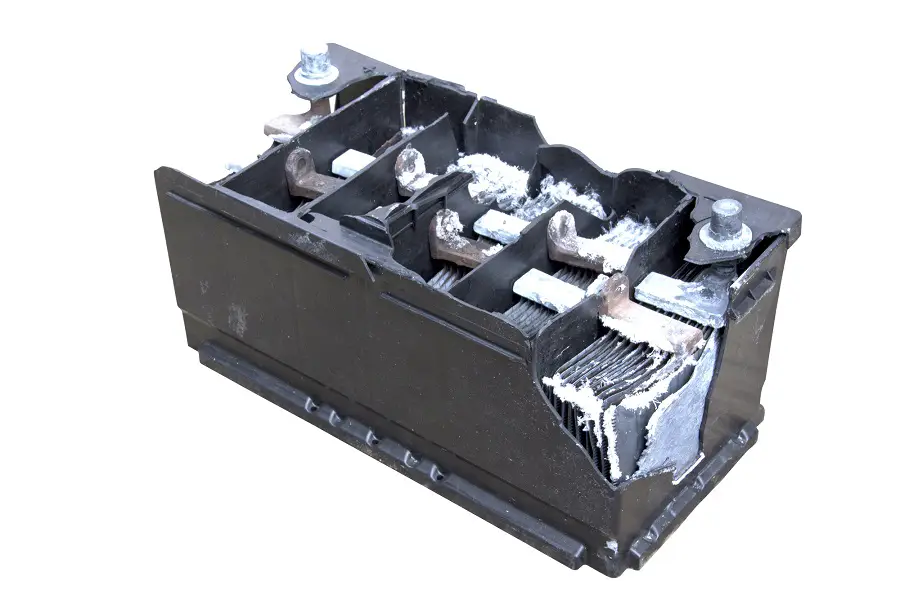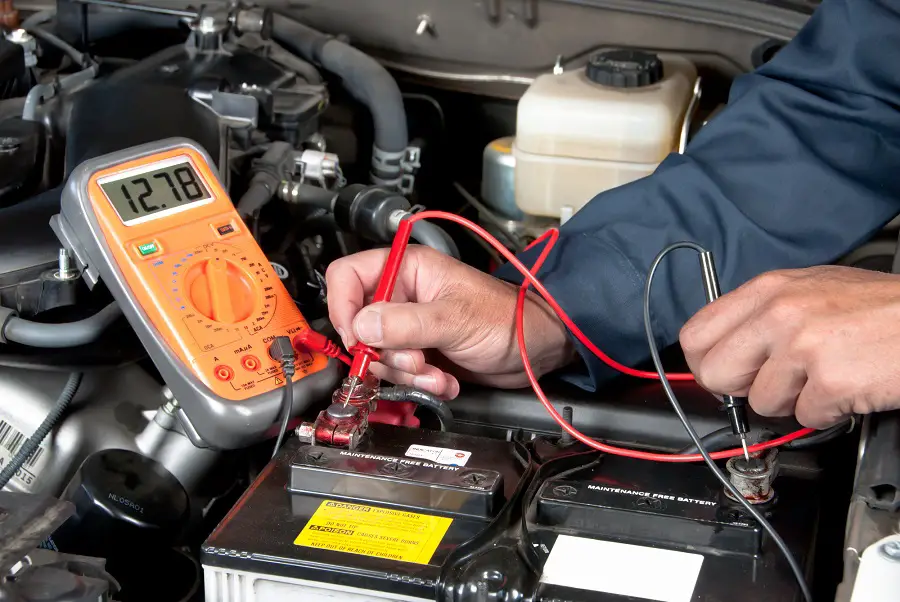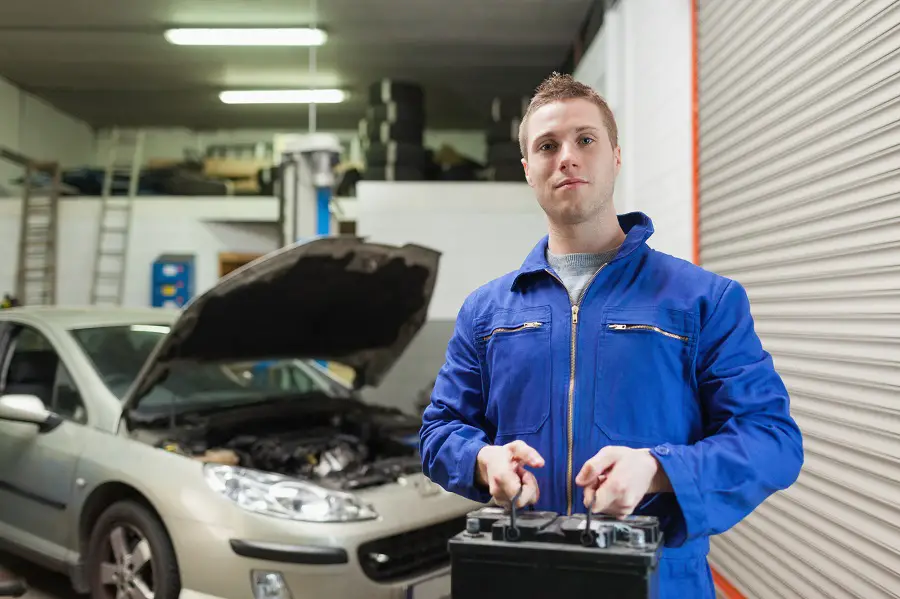Just after getting my son’s project truck into the driveway, we spent a few hours crawling all over it exploring all the features, problems and cool accessories.
We must have left an interior light on, because the next time we went to work on it, it wouldn’t start.
Nearly every car owner has, at some point, turned the ignition key and found themselves greeted by a clicking sound, or worse, total silence from under the hood.
Stupid dead battery!
When your car battery drains due to a power draw (or leakage if you leave something on while the car is off), and it isn’t recharged to full capacity before you use the next time, you will be faced with a dead battery. This is one that doesn’t have adequate power to crank over your engine.
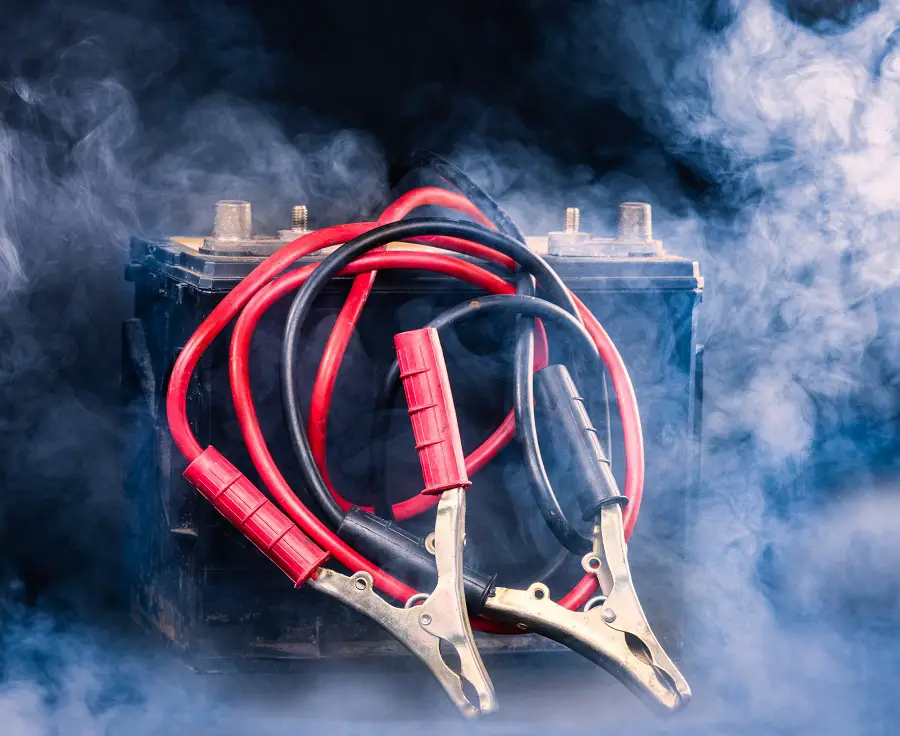
We can’t help you with the fact that this happens when you’re already late for wherever you’re going, but we can talk about the best ways to remedy your car battery problems.
But first, let’s talk about how to tell if your battery is low, dead or bad.
How to Tell If It’s a Dead Battery
If your car starts and drives just fine one moment and a short time later won’t turn over, there are only a few explanations for this.
- The battery is low: your battery was drained because you left an accessory on, your battery is going bad so it’s not fully charged or it’s not holding a charge. You will see evidence of a battery going bad in cold weather due to the higher requirement for amps needed to turn a car over when it’s cold.
- The battery is dead: your battery has given up the ghost and will no longer hold a charge. (we wrote about how to test if your battery is bad, not just dead, and how to determine it in this article here). A battery goes bad over a period of time – this is known as battery life. Most batteries are sold detailing the number of months they’ll last.
- The battery is new, but is bad: something is wrong with the battery exterior, interior, its connections. Sometimes new batteries will go bad and need to be returned (check out this great deep dive on battery warranties and this one about returning a bad battery)
Unless you’ve got something weird going on (like loose battery cables or worn-out battery cells), the issue at hand is usually a low or dead battery.
Most of us know enough about cars to realize that battery power is what kicks the engine off when you turn the key (i.e. turn the starter over, which engages the engine and through the process of combustion the engine “starts”).
While the battery doesn’t do much related to the combustion engine after the combustion has started, there are electrical devices in your car that draw power from it and your alternator while the engine runs.
Headlights, the radio, the computer, your fancy heads-up display, and all manner of electronics need electricity. Therefore, if your battery is dead, even if you could get your car started, you can’t do much with it unless your alternator is strong enough to power everything (most are, but in a few instances I’ve seen a dead battery cause the car to cut out while running when the headlights are turned on, for example, but that’s most often a sign that the alternator is bad)
There are various reasons why your battery might go dead — maybe you left the headlights on, the door was left ajar slightly so the interior lights stayed on, there’s some electrical issue causing a power drain, or your battery is just too old to hold a charge anymore.
What we’re concerned with here is coming up with a solution and getting a charge into the battery so you can go on about your day.
Charging Your Battery
Most people have a set of jumper cables in the trunk of their car. Well, okay, some people. I’m just now realizing that since I got my new (to me) car, I have yet to put cables in it. Anyway, while jumping your dead battery is an option, it is not the best one if you want long-term charging.
Jumping a dead battery is great if your battery is good and can hold a charge. It’s a quick way to “borrow” power, short-term, from another battery.
But, if your battery is going bad jumping isn’t a fix. It’s a band-aid and you should replace your battery.
If you know your battery is good (because you’ve tested it according to our steps outlined in this article), then here are s a few ways you can restore power to your car battery. Sometimes all your car needs is a quick battery charge to get it back on the road.
Using the Car’s Alternator
You can use your car’s alternator to charge your battery whenever the engine is running. The alternator has a set of magnets in it that surround a coil. The engine turns the alternator’s rotor shaft (via a pulley), and these spinning magnets generate an alternating current.
The alternator has a rectifier in it, and its job is to convert that AC into direct current, which then powers the electric stuff in your car.
It also recharges your battery with that DC, so if your alternator goes bad, your battery can’t recharge. Start your car a few times with a bad alternator, and eventually, the battery runs out of juice. With a working alternator, you charge your battery with it simply by running the engine.
How long does it take to charge a battery with the alternator?
As with most questions, the answer could start with “It Depends”. Because many factors come into play when determining how long a battery will take to charge. Like the type of battery, how dead it is, the type of charger, battery size and battery capacity.
There is a lot of fancy math you can do to figure this out since most alternators output between 13.2 and 14.8 volts while running. A fully charged battery will be around 12.5 volts. Add, divide, multiply and do a little dance and you can get close to 15 minutes for a mildly low battery.
For a battery that is really discharged, it can take up to 30 minutes to fully charge it using the alternator. Of course, your car has to be running the whole time.
Using a Trickle Charger
A trickle charger represents the safest way to charge your battery, as it provides a charge at low amperage. Slowly charging a battery means less chance of damage to its inner workings due to how a lead-acid battery works.
Inside it are lead plates and sulfuric acid. When the battery pushes out electricity, it is due to a chemical reaction in which the lead plates change to lead sulfate. The electrolyte solution of sulfuric acid gets diluted as sulfur goes from it to the lead.
When you charge your battery, you are essentially reversing this process. Lead sulfate goes back to being lead, and the sulfur returns to the sulfuric acid. Charging your battery too quickly or overcharging it can create heat and off-gassing, creating harmful fumes. An explosion is also a possibility.
A trickle charger, then, provides a safe, constant charge to your battery. More advanced models, like this DeWalt DXAEWPC4 Battery Charger, can monitor the battery and shut itself off when it’s reached full charge.
How long does it take to charge a battery using a trickle charger?
A trickle charger’s biggest selling point is that it “trickles” the power back into the battery. We know this isn’t actually what happens, but it’s the easiest way to explain it.
As we said, this is the safest and least damaging way to recharge your battery. But because of this methodology, a trickle charger can take some time to fully recharge a battery – especially if it is really discharged.
I’ve seen trickle chargers take anywhere from 4 to 8 hours to recharge a battery.
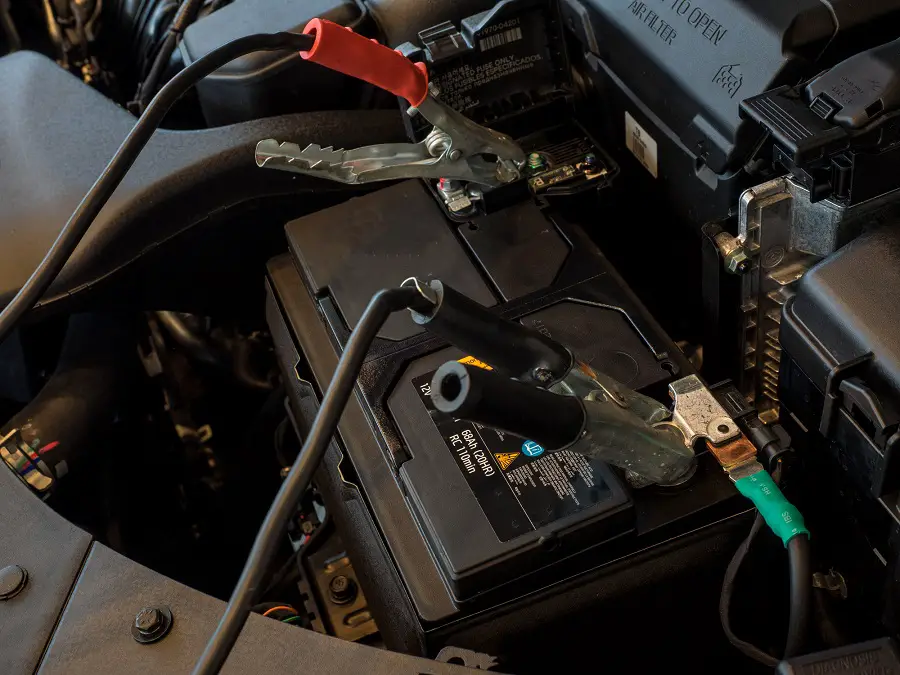
Jumper Cables or a Booster Box
As mentioned earlier, these are sometimes more practical, especially if your battery has died when you don’t have ready access to your garage and your tools, like if it died while you were at your office.
Jumper cables can tax the battery of the car while you’re connected due to the speed at which it’s transferring power and in some rare cases, it can cause problems to the car’s alternator if you leave the cables connected for an extended period while the car is running.
You should use jumper cables sparingly. If you find that you have to get a jump a few times each week, you should probably test your battery or your alternator – because something isn’t working as intended (You may have something that is discharging the battery while the car is off. You should check that out as well).
If your battery needs a jump every day, that’s just bad news all around. Still, we need to do it from time to time so see below on how to properly jump a car.
A booster box is a portable device that holds a charge and allows you to “jump” a battery from the power stored in the unit. It works fast but is limited as it drains quickly before requiring a recharge.
The benefit of a booster box is that it can go just about anywhere and you don’t have to worry about having room to pull a car close enough & cables long enough to use jumper cables.
How long does it take to charge a battery using jumper cables or a booster box?
Jumper cables are one of the fastest ways to charge a car battery. This is because you’re sending the full amount of power to the dead battery from the running car (basically jumping from the running car’s alternator – hence the name “jumper cables”).
Most jumped cars will “charge” within a few seconds and can be started. At this point, the alternator takes over and charges the rest of the battery.
If you’re dumb enough to try and fully charge the battery using jumper cables (and both running cars), it will probably take 5-10 minutes. But that’s not advised.
Because it charges so fast, it can cause damage and be a bit dangerous. So it is a short-term solution at best. Get it jumped, started and running under its own power & charging process as soon as you can.
How to Jump a Car Battery – It’s a Simple Process
If you ever have to jump a car then you want to make sure you do it correctly. It may seem basic, but it’s important to note that jumper cables have “jaws” on both ends. A red clamp and a black clamp on both sides. They correlate to positive clamps (red) and negative clamps (black).
Each side is for one vehicle. The car that is jumping the dead vehicle will get a red & black clamp and the same goes for the other side. I know this explanation is elementary level, but it needed to be said.
The red clamps are for positive connections, the black clamp connects to negative battery terminals or gets grounded to the frame, engine block or another bare metal surface in the engine compartment.
Whether you’re getting a jump or jumping someone else who may be stranded, here are the steps:
- Turn off all the electrical devices in your both vehicles (obviously the dead car is already off, but turn dials and knobs to the off position anyway, if you can).
- Have the charged vehicle turned on and idling.
- Attach the positive (red) cable to the positive terminal of the charged vehicle’s battery.
- Attach the other positive (red) cable to the positive terminal of the dead battery.
- Attach the black negative cable to the negative terminal of the charged battery. At this point, it’s important that you know where the other end of your black jumper cables are. If it’s touching the other car or grounded out in any way, you will get some sparks and may damage something.
- Attach the other negative (black) cable to an unpainted metal surface somewhere on the vehicle with the dead battery. While you technically can attach it to the negative terminal of the dead battery, it’s a safe, and common practice, to ground it to the frame of the dead car so it doesn’t charge too quickly or damage the dead battery further. (If you forget the order, just remember that you always connect red first so you don’t accidentally ground it out – GO AHEAD WITH RED)
- Wait a few minutes for the charge to build up in the dead battery.
- Start the dead vehicle and let it idle for a bit to engage the alternator
If your car doesn’t start up immediately, try waiting a bit longer as it gives it time to charge the dead battery. However, if your battery is completely depleted, you still might not be able to restart your car.
PRO TIP
This process for jumping a dead car battery is almost universal among all cars. HOWEVER, use caution when jumping or being jumped with newer cars. The highly sensitive and specialized electronics can take damage if you use the “standard” process.
I may have mentioned before that I fried my Volvo at one point by jumping it incorrectly. I grounded the jumper cables to the wrong thing and it messed up the fiber optics that run the car’s electronics.
They quoted me $6,000 for the repair! That could have been an expensive jump. Since I had only paid $1,000 for the car used I decided to donate it instead of getting the repair.
So, How Long Does It Take to Charge a Car Battery? The Short Version.
As we saw above, when you use jumper cables, it shouldn’t take more than a minute to charge a battery enough to get it started. When using a trickle charger, it takes several hours or a period of time greater than an hour.
Since some trickle chargers have adjustable amperage, allowing for faster or slower charging. There is no hard-and-fast rule as to how long charging takes. Generally, it is an overnight job. Set the trickle charger up, go to bed, and if all is well with your battery, you’ll be good to go in the morning.
Just make sure it’s connected correctly – fire danger and all that.
What To Do If Your Car Battery Won’t Charge
Several problems can cause a failure to charge. They can also answer the question of what if your battery isn’t holding a charge.
The easiest fix is to check the battery terminals. If they’re dirty or corroded, the cables you connect to the battery may not make a connection. Using a wire brush, you can scrub away the corrosion.
A Shadetree mechanic solution is to pour Coca-Cola over them. This really works. Just be sure to rinse away the Coke and the corrosion it chewed off your terminals.
If your battery’s cells are bad, there are DIY fixes available, but this is a solution for someone who knows what they’re doing. If your battery doesn’t hold a charge because it’s too old, you’re much better off simply replacing it.
If you find your battery will charge, but it won’t charge past 75%, you could have an old or worn-out battery. You could also be dealing with an electrical issue in your vehicle, drawing power away from the battery. Either way, you’ll need to take action past just hooking up some cables.
We depend heavily on our cars. When they don’t start like they’re supposed to, we are, at the very least, inconvenienced. Knowing how to charge a dead battery safely is important to the continued health of your car’s battery and systems.
Be sure to approach the problem carefully and safely, and if you need to call in a professional, don’t hesitate. You risk your car and your safety if things go wrong.
The number of people I’ve seen who have charged a battery wrong would shock you! You should be in charge of doing it correctly.

